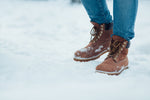
Can You Wear Leather Boots in the Snow?
, by Ed Stone, 5 min reading time

, by Ed Stone, 5 min reading time
Leather is one of the most coveted materials used to make boots, known for its superior durability, sleek look, and (let’s be honest) feisty attitude. But can this fashion-forward material be a reliable option for cold-weather footwear? When the winter season’s first flurries start to hit, are leather boots good for snow?
In short, it is possible to wear your leather winter boots out in light snow conditions but is leather waterproof? Although durable, it is not completely waterproof, so you’ll need to equip your boots with a weather-resistant, extra warmth membrane by treating them first.
With this quick guide, we’ll teach how to ensure your leather boots can stand up to snow, sleet, and icy temperatures and what to consider before taking them out for a proper snowy romp.
For most standard leather boots you’ll buy off the shelf, snow and winter weather is a no-go. If you wear them in the snow without treating them, moisture and cold weather can cause:1
That said, there are three techniques you can use to help your doc martens boots, timberland boots for men and women, or any of your favorite leather boots brave the elements if you need to take them out for a quick walk in light snow.
There are quite a few curing products available that you can use to keep deep snow and moisture leeching into leather boots.
We recommend two solutions for treating them for water resistance:
Water-resistant treatments work by creating a buffer between your boots and the elements. But to optimize their efficacy, you’ll need to take care of the leather itself by:
If you live in a city or small town, you probably know that streets are often treated with salts to melt icy sidewalks during the winter season. Unfortunately, salt can also diminish the lifespan and look of leather boots by degrading their material.
To remedy existing salt stains, take these steps:2
This solution can help to restore the visible condition of minor salt stains. That said, leather boots will fare best if you weather-proof them before trotting out onto freshly salted streets.
If you live in or frequently visit an area that sees frequent snow and winter weather, a pair of dedicated snow boots may be a wiser investment. In comparison to a standard pair of leather boots, snow boots often feature:
That said, there are some styles of leather boots with a built-in waterproof membrane to repel moisture. Similarly, many types of snow boots are constructed from materials that resemble the look and finish of leather (like faux leather)—without their susceptibility to inclement weather.
When in doubt, consult with an experienced boot specialist before your purchase. They can help you get the best of both worlds: the rugged look and feel of leather, with the textiles and synthetic insulation you can rely on to keep your toes dry and toasty.
A common misunderstanding for some people is that a rain boot can work as a substitute for a snow boot, when in reality, they’re quite different. To understand the difference between rain boots vs. snow boots, make sure to check out our blog to see which ones are the right fit for you.
From snow to steel-toed, Boot World has the boots you need for any weather condition. Whether you’re planning a trek through the mountains or hiking a snow-laden trail, we’ll make sure your boots are up for the task and can help answer any questions you may have regarding your winter footwear, like “should winter boots be a size bigger?”, to boot insulation tips and tricks.
After over 40 years in the footwear business, Boot World remains a family-operated West Coast firm—and we treat our customers like family. We take pride in advising and outfitting our customers with the best boots for their lifestyle, so use our store locator to find your local Boot World today.